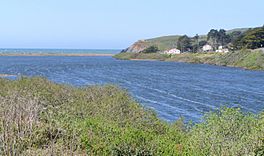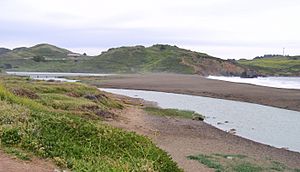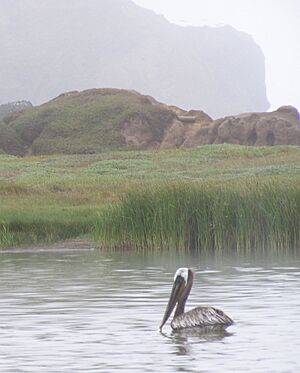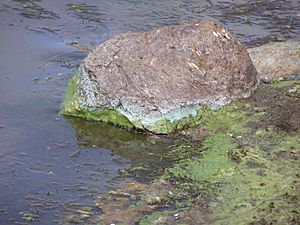Rodeo Lagoon facts for kids
Quick facts for kids Rodeo Lagoon |
|
|---|---|

Rodeo Lagoon, viewed on a windy day from its southeast corner
|
|
| Location | Marin County, California |
| Coordinates | 37°49′51″N 122°31′52″W / 37.83083°N 122.53111°W |
| Type | lagoon |
| Max. length | 900 metres (3,000 ft) |
| Max. width | 250 metres (820 ft) |
| Surface area | 15 hectares (37 acres) |
| Max. depth | 2 metres (6.6 ft) |
Rodeo Lagoon is a cool coastal lagoon found in the Marin Headlands. This area is part of the Golden Gate National Recreation Area in southern Marin County, California. A lagoon is a shallow body of water that is partly separated from a larger body of water, like an ocean.
Rodeo Lagoon is a brackish water body. This means its water is a mix of fresh and salty water. A sand bar, which forms Rodeo Beach, separates the lagoon from the Pacific Ocean. The lagoon is about 900 meters (2,950 feet) long and 250 meters (820 feet) wide. At its deepest, it's about 2 meters (6.6 feet) deep. The lagoon covers an area of about 15 hectares (37 acres).
Contents
How Water Moves In and Out
Rodeo Lagoon connects to the Pacific Ocean when its water level gets very high. This usually happens in the winter when there's a lot of rain. The high water pushes through the sand bar, creating an opening.
During the dry summer months, the sand bar completely blocks the lagoon from the ocean. This means very little water moves between the lagoon and the ocean at that time.
The amount of water in the lagoon changes a lot. Its depth, size, and total water volume depend on how high the sand bar is and how much rain falls. For example, the center of the lagoon can be less than 1.5 meters (5 feet) deep in a dry summer. But it can reach almost 3 meters (10 feet) deep in a wet winter.
Ocean tides do not affect how water moves in Rodeo Lagoon. Instead, the wind does most of the work! The Marin Headlands are often very windy. This wind creates patterns on the water's surface, sometimes even making lines of foam.
The water in Rodeo Lagoon is usually a little salty, but not as salty as the ocean. Most of the lagoon has a salinity (saltiness) level between 2 and 10 units. However, the water at the bottom of the lagoon can be much saltier, sometimes reaching 25 units. This dense, salty water gets trapped at the bottom because of the lagoon's bowl shape. This makes it hard for it to flow back out to the ocean.
Amazing Wildlife
Rodeo Lagoon is home to many cool animals, including a special protected fish called the tidewater goby. Many different kinds of migrating birds also visit the lagoon. Other fish that live here include the threespine stickleback and prickly sculpin.
You might even spot a family of river otters! They often use the lagoon and sometimes eat brown pelicans in the summer. The edges of the lagoon are lined with plants like willows and cattails. In the shallow parts, you can find underwater plants like sago pondweed and widgeon grass.
Tiny plant-like organisms called phytoplankton also live in the lagoon. Some of these, like Microcystis sp. and Nodularia sp., are types of cyanobacteria. These can sometimes release toxins that make the water unhealthy.
Too Much Algae
Sometimes, especially in the summer, there are way too many phytoplankton in the lagoon. This is called eutrophication, which means the water has too many nutrients, causing huge amounts of algae to grow.
When there's a lot of algae, you might even see a green scum on the water's surface. This large amount of algae can cause problems. When the algae die, they use up a lot of the oxygen in the water. This can lead to low oxygen levels, which is bad for fish and other animals.
The large amount of algae also makes the water's pH level very high. The pH is a measure of how acidic or basic something is. A high pH means the water is more basic. During these big algae blooms in summer, the pH is often higher than 9.
Lagoon History
Rodeo Lagoon was mostly natural until the U.S. military built Fort Cronkhite and Fort Barry nearby. In 1937, the Army built a road across the east side of the lagoon. This made the lagoon smaller because the area behind the road slowly turned into a freshwater marsh. Today, the lagoon is about 80% of its original size.
Fun Things to Do
You are not allowed to swim or play in Rodeo Lagoon itself. This is to protect the water quality and the wildlife. However, the lagoon and the area around it are fantastic for watching wildlife! It's a great spot for birdwatching and seeing the playful river otters.
Images for kids






